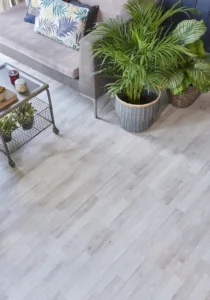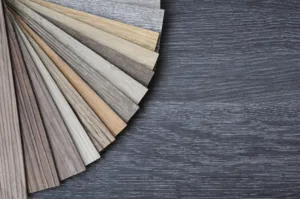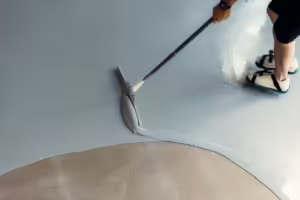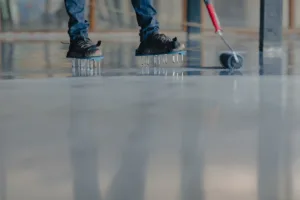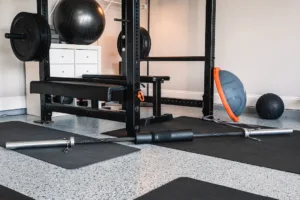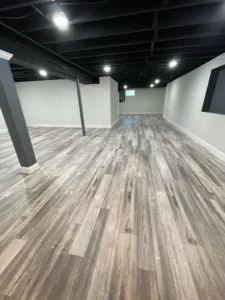Epoxy flooring is no longer a secret kept within the confines of warehouses and industrial complexes – it has crossed into the public eye, capturing the imagination of homeowners, business owners, and property managers alike. This comprehensive guide is designed to walk you through the ins and outs of what epoxy flooring is, explore its types – particularly metallic and flake – and dissect its benefits and cost implications.
Introduction to Epoxy Flooring
Epoxy flooring is a liquid-applied coating that hardens into a smooth, durable surface. It’s made by mixing a resin with a hardener, which then chemically bonds to whatever surface it’s applied on, typically concrete. Epoxy floors are renowned for their longevity and versatility, offering an aesthetic appeal that can complement any design vision.
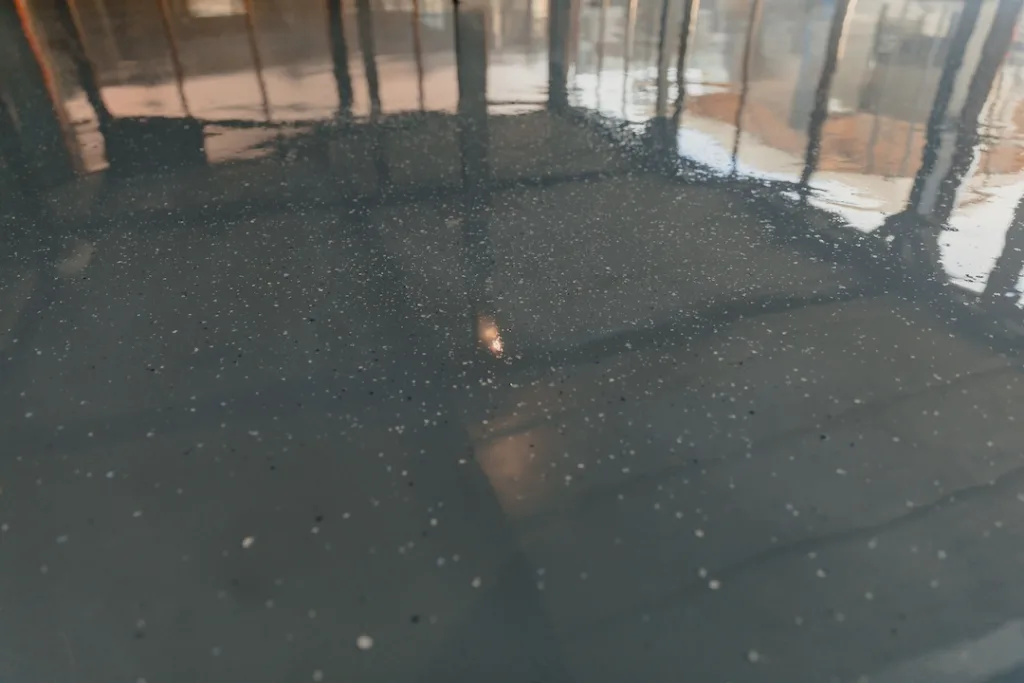
Types of Epoxy Flooring
When exploring the diverse world of epoxy flooring, two standout types are particularly notable for their unique characteristics and applications: Metallic and Flake epoxy floors.
Flake Epoxy Floors
On the flip side, flake epoxy floors infuse colored chips or flakes into the epoxy, providing a texture that increases slip resistance and adds a decorative flair. These are ideal for areas requiring more grip, such as garages, schools, and commercial bathrooms.
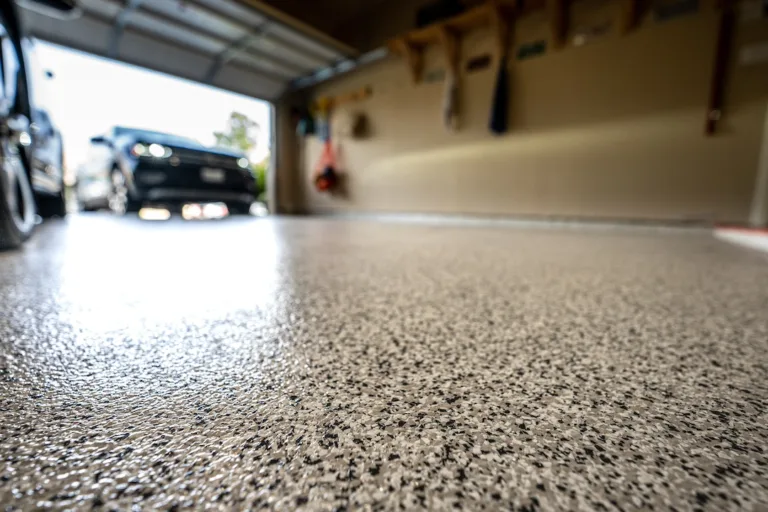
Metallic Epoxy Floors
Metallic epoxy floors use a combination of metallic additives mixed into clear epoxy to create a luminous, iridescent finish that resembles marble or swirling patterns. These floors are particularly well-suited for showrooms, lobbies, and residential spaces where a unique, high-end look is desired.
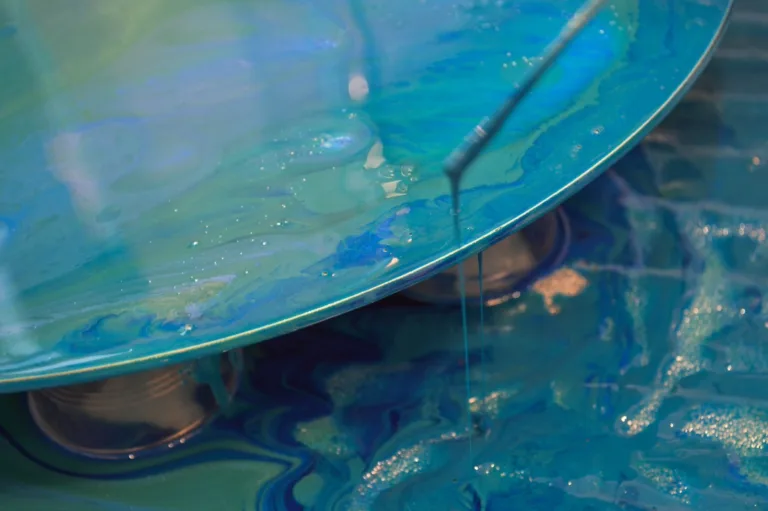
Benefits of Epoxy Flooring
The durability of epoxy flooring is unmatched – it withstands heavy traffic, impacts, and chemical spills. Customization is another feather in its cap; you can choose from a wide range of colors and textures to match your space. Additionally, epoxy’s seamless nature makes it easy to clean and maintain. Despite misconceptions, it’s a cost-effective solution especially considering its longevity.
- Cost-Effectiveness: Initially, epoxy flooring might seem like an expensive option, but its durability and long lifespan mean it is highly cost-effective over time.
- Versatility: Epoxy floors can be applied in a variety of settings, from industrial warehouses to residential kitchens, making it a versatile choice for many.
- Ease of Maintenance: Due to its seamless surface, epoxy flooring is incredibly easy to clean and maintain, resisting stains and spills.
- Aesthetic Appeal: With a range of colors, patterns, and finishes, epoxy floors offer considerable aesthetic flexibility to match any décor.
- Chemical Resistance: Epoxy flooring is resistant to chemicals, making it ideal for factories, garages, and laboratories where spills may occur.
- Safety Features: Adding elements like anti-slip additives can make epoxy flooring safer in wet or high-traffic areas.
- Eco-Friendly Options: Some epoxy coatings are made from environmentally friendly materials, offering a sustainable flooring solution.
Epoxy Flooring Application Process
The application of epoxy flooring begins with surface preparation – cleaning, repairs, and ensuring the concrete substrate is ready to bond with the epoxy. Next comes the installation, where the mixed epoxy is poured and spread evenly. These layers then need to cure, turning into a hard, cohesive surface. Proper post-installation care can extend the life of the floor significantly.
Surface Preparation
- Cleaning: Removal of all debris, dust, and stains from the concrete surface to ensure a clean bonding site for the epoxy coating.
- Repairing: Filling in cracks, chips, and holes in the concrete floor to prevent any imperfections from affecting the final appearance.
- Profiling: This step may involve either mechanical grinding or applying a chemical etcher to the concrete surface to ensure the epoxy properly adheres.
Epoxy Mixing and Application
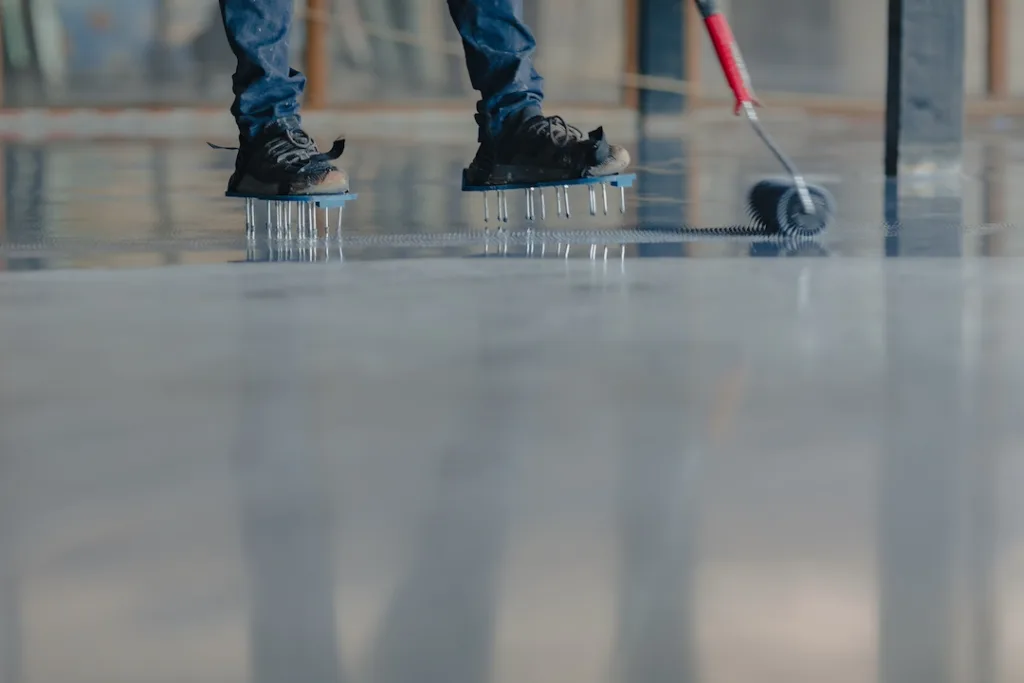
- Mixing the Epoxy Resin and Hardener: Following manufacturer instructions to mix the resin and hardener components in the correct ratio.
- Applying the Base Coat: The mixed epoxy is then applied to the prepared surface, starting from one corner and working systematically across the floor.
- Adding Decorative Flakes or Metallic Pigments: If using flake or metallic epoxy, this step involves broadcasting the flakes or blending the pigments into the base coat while it’s still wet.
Curing and Sealing
- Curing: Allowing the epoxy to cure and harden over a specified period, typically 24-72 hours, depending on the product and environmental conditions.
- Top Coat Application: Applying a top coat to seal the epoxy, enhance its durability, and achieve the desired gloss or matte finish.
- Final Curing: The top coat then needs to cure, completing the process and ensuring the floor is ready for use—usually within a few days.
Epoxy Flooring Cost
The cost of epoxy flooring can vary greatly based on factors such as the total area, the type of epoxy (metallic, flake, or standard), and design complexity. You also have to consider the current state of the floor, geographical location, and the professional labor involved.
Cost Comparison with Other Flooring Options
When comparing epoxy flooring to other popular flooring options such as tile, hardwood, and carpet, it’s important to consider both the initial installation costs and long-term maintenance expenses.
- Tile Flooring: Initial costs for tile can be moderate to high, depending on the material (ceramic, porcelain, stone). However, tile requires grout maintenance and can crack, leading to potential additional costs over time.
- Hardwood Flooring: Hardwood is among the more expensive flooring options both in terms of materials and installation. It also necessitates regular maintenance, including refinishing, to maintain its appearance and durability.
- Carpet: Carpeting offers a lower initial cost but can require more frequent replacements and intensive cleaning, especially in high-traffic areas, thereby increasing its long-term cost.
- Concrete: Polished concrete is a cost-effective alternative with lower initial costs than epoxy. However, it does not offer the same level of customization, durability, or chemical resistance that epoxy flooring provides.
In comparison, epoxy flooring presents a unique value proposition. While the upfront cost may be higher than some alternatives like carpet or basic concrete, the remarkable longevity and minimal maintenance requirements of epoxy flooring can result in lower costs over the lifespan of the floor. Additionally, its versatility and durability in both residential and commercial settings make it a financially sound choice for a wide range of projects.
Can I DIY Epoxy Flooring?
No. Epoxy is a dangerous substance.
The prospect of installing epoxy flooring by oneself might seem like a cost-saving and rewarding DIY project. However, it’s essential to understand that working with epoxy resin requires specific skills, knowledge, and equipment, making it more complex and potentially dangerous than typical home improvement tasks. The process involves handling chemicals that can emit harmful fumes, posing significant health risks if not managed with proper safety gear and adequate ventilation.
Additionally, achieving a flawless, durable finish necessitates precision in mixing, applying, and curing the epoxy—tasks that are challenging without professional experience.
Fixing Improper Epoxy Installation Will Cost MORE Than A Professional From The Start
Improperly installed epoxy flooring can lead to peeling, bubbling, and uneven finishes, negating the material’s long-term benefits. Consequently, while the DIY approach might seem appealing, the potential health risks and the high probability of suboptimal results strongly suggest hiring professional installers with the expertise to ensure a safe and successful application.
Frequently Asked Epoxy Floor Questions
Yes, when properly installed and cured, it is highly resistant to scratching.
While epoxy flooring is durable, it is not typically recommended for outdoor use due to UV exposure. If you use epoxy in an outdoor setting, make sure its away from the sun.
With proper installation and maintenance, epoxy flooring can last for decades.
Epoxy floors require minimal maintenance. Regular sweeping and occasional mopping with a mild soap are usually sufficient to keep the floor looking new.
Epoxy flooring can be slippery, especially when wet. However, anti-slip additives can be incorporated into the topcoat to create a safer, more traction-friendly surface.
Yes, epoxy can be applied over existing tile, but the surface needs to be properly prepared to ensure good adhesion. This may include repairing damaged tiles and grouting to create a smooth, level surface.
While epoxy flooring is extremely durable and versatile, it may not be the best choice for environments that are continuously damp or have frequent temperature fluctuations, as these conditions can affect the longevity and appearance of the flooring.
In Conclusion
Epoxy flooring offers a robust, attractive, and versatile solution for nearly any space. While the upfront costs may seem steep for some, the investment pays off in the form of longevity, aesthetics, and low maintenance. Current trends indicate a growing preference for personalized and environmentally friendly options in epoxy flooring, pointing to a future where the only limit is one’s imagination.
Whether you are outfitting a home garage or revamping a commercial space, epoxy flooring is certainly an option worth considering. With this guide in hand, you are well on your way to making an informed decision about whether epoxy flooring is the right choice for your space.


